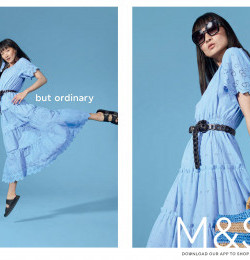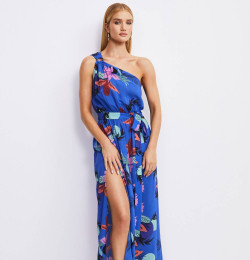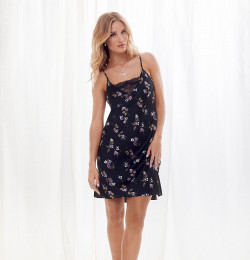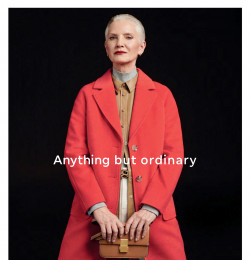Marks & Spencer (M&S) is a major British retailer, with over 895 stores in more than 40 territories around the world, over 600 domestic and 295 international. The company, with its head office in the Waterside House in the City of Westminster, London, England, is the largest clothing retailer in the United Kingdom, as well as being an upmarket food retailer, and as of 2008, the 43rd largest retailer in the world. Most of its domestic stores sell both clothing and food, and since the turn of the century it has started expanding into other ranges such as homewares, furniture and technology.
In 1998 it became the first British retailer to make a pre-tax profit of over £1 billion, though a few years later it plunged into a crisis which lasted for several years. In November 2009, it was announced that Marc Bolland, formerly of Morrisons, would take over as chief executive from Stuart Rose in early 2010; Rose will continue as chairman until mid-2011.
It is listed on the London Stock Exchange and is a constituent of the FTSE 100 Index.
history
The company was founded by a partnership between Michael Marks, a Litvak Jew from Slonim, Poland (now in Belarus), and Thomas Spencer, a cashier from Yorkshire. On his arrival in England, Marks worked for a company in Leeds, called Barran, which employed refugees. In 1884 he met Isaac Dewhurst, the owner of a Leeds warehouse, which resulted in him opening his own stall on Kirkgate Market, in Leeds.
The next few years saw Michael Marks open market stalls in many locations around the North West of England. In 1894, Thomas Spencer invested in Marks' activities and they opened their first store, in partnership, at 20 Cheetham Hill Road, Manchester.
In 1901 Marks and Spencer built a warehouse at Derby Street, Manchester. It was the first property built to their specifications and became the Compan’s first registered address and headquarters.
In 1903 Marks and Spencer Ltd was registered as a firm with a capital of 30,000 £1 shares. These were split equally between the two founders.
Spencer died on 25 July 1905, having retired from business two years earlier. William Chapman was executor of the Spencer estate, and was appointed to the Board of Directors to represent the Spencer family’s interests.
Michael Marks died on 31 December 1907. Michaels’s son Simon had joined the Company two months before. William Chapman became Chairman of the Company.
Marks and Spencer bought Arcadia in 1911, a small chain of Penny Bazaars based in the South of England.
In December 1911, Simon Mark’s was elected to the Board of Directors. Simon was specifically responsible for the buying of merchandise.
In 1914 Marks and Spencer bought the London Penny Bazaar Company.
In 1915 Israel Sieff was elected to the Board of Directors. Israel was a very close friend of Simon Marks; he went on to develop the Company’s export business.
Following a lengthy legal battle between Simon Marks and Willian Chapman, Simon became Chairman at the age of 28. Simon was to lead the company for 56 years.
In 1924 the Company’s Head Office and registered address moved from Manchester to London.
In 1926 Marks and Spencer adopted the revolutionary policy of buying goods directly from the manufacturers. This cut costs and allowed a greater level of quality control.
Israel Sieff was appointed Vice Chairman in 1926. This was the beginning of a thirty-eight year partnership between Simon Marks and Israel Sieff, during which time the two men laid the foundation of the modern business.
The St. Michael trademark was introduced in 1928 as a guarantee of quality and value. Initially used only for a small range of textiles made to Marks and Spencer specifications, the St. Michael range was extended over the years to cover all goods sold in M&S as they phased out the selling of other brands, with the first St Michael food being introduced in 1941. Several other Marks and Spencer brands also existed at this point, including ‘Marspen’ – a range of household goods and children’s books – and ‘Welbeck’ – a food range including biscuits and other baked goods.
In 1930 the first flagship store was opened at Marble Arch, London. Originally located in the basement and ground floor of a newly erected office block, the store has since expanded to encompass four floors and is a prominent landmark of Oxford Street.
A food department was introduced selling produce and canned goods. This range was greatly expanded in 1934, and by the outbreak of the Second World War, Marks and Spencer was one of the biggest food suppliers in the country.
In 1933 Simon Marks commissioned Flora Solomon to set up an employee welfare service that provided pensions, subsidized employee canteens, health and dental services, hairdressing, rest rooms and camping holidays.
A Scientific Research Lab was established, headed by Dr. Eric Kann in 1934. This was the first research lab on any British retailer to pr-test garments and research innovative new fabrics. Between 1935 and 1939 the lab carried out over 9000 tests on the wearability, washability and durability of textiles.
Café Bars were introduced, with the first one in Leeds opening in 1935. They provided cheap, hygienic and nutritious mass catering. This was a valuable resource during the Second World War, making efficient use of scarce food. By 1942 there were 82 café bars and customers were able to pay with their ration tokens. Following the end of rationing in the 1950s, Café Bars were taking up valuable sales floor area and were gradually phased out to make room for more stock.
Marcus Sieff, son of Israel Sieff, joined the Company in 1935. Marcus took on responsibility for streamlining operations, and for administration of personnel. Marcus was also responsible for the expansion of the food business following the Second World War.
At the outbreak of the Second World War, Marks and Spencer had 234 stores. By 1945, over 100 of these had been damaged by bombs, and 16 had been completely destroyed.
By 1950, virtually all goods were sold under the "St Michael" label. M&S lingerie, women's clothes and girls' school uniform were branded under the "St Margaret" label until the whole range of general merchandise became St Michael. Simon Marks, son of Michael Marks, died in 1964, after fifty-six years' service. Israel Sieff took over as Chairman. A cautious international expansion began with the introduction of Asian food in 1974. M&S opened stores in continental Europe in 1975 and in Ireland four years later.
The company put its main emphasis on quality, including a 1957 stocking size measuring system. But for most of its history it also had a reputation for offering fair value for money. When this reputation began to waver, it encountered serious difficulties. Arguably, M&S has historically been an iconic retailer of 'British Quality Goods'.
All international stores are operated under franchise, with the exception of the stores in the Republic of Ireland and Hong Kong which remain in company ownership.
The first M&S store in central Asia was built in Kabul, Afghanistan in the 1960s. The store was later shut down.
M&S expanded into Canada in 1973, and at one point had forty seven stores across Canada. Despite various efforts to improve its image, the chain was never able to move beyond its reputation there as a stodgy retailer, one that catered primarily to senior citizens and expatriate Britons. The stores in Canada were smaller than British outlets, and did not carry the same selection. In the late 1990s, further efforts were made to modernize the stores and expand the customer base, and unprofitable locations were closed. Nonetheless, the Canadian operations continued to lose money, and the last 38 stores in Canada were closed in 1999.
Expansion into France began with stores opening in Paris at Boulevard Haussmann and Lyon in 1975, followed by a second Paris store at Rosny 2 in 1977. Further expansion into other French and Belgian cities followed into the 1980s. Although the Paris stores remained popular and profitable, the whole of the Western European operation did not fare as well and eighteen stores were sold in 2001.
In 1988 the company acquired Brooks Brothers, an American clothing company and Kings Super Markets, a US food chain. They were subsequently sold off, in 2001 and 2006 respectively.
M&S's profits peaked in financial year 1997/1998. At the time it was seen as a continuing success story, but with hindsight it is considered that during Sir Richard Greenbury's tenure as head of the company, profit margins were pushed to untenable levels, and the loyalty of its customers was seriously eroded. The rising cost of using British suppliers was also a burden, as rival retailers increasingly imported their goods from low-cost countries, but M&S's belated switch to overseas suppliers undermined a core part of its appeal to the public. Another factor was the company's refusal until 2001 to accept any credit cards except its own store card.
These factors combined to plunge M&S into a sudden slump, which took the company, its shareholders, who included hundreds of thousands of small investors, and nearly all retail analysts and business journalists, by surprise. The company's share price fell by more than two thirds, and its profits fell from more than a billion pounds in 1997 and 1998 to £145 million in the year ended 31 March 2001.
In 2001, with changes in its business focus such as accepting credit cards, the introduction of the "per una" clothing range designed by George Davies, accompanied by a redesign of its underlying business model, profits recovered somewhat and M&S recovered some of its market share, but it was soon evident that problems remained.
In 2004, M&S was in the throes of an attempted takeover by Arcadia Group & BHS boss, Philip Green. On 12 July a recovery plan was announced which would involve selling off the financial services business to HSBC Bank plc, buying control of the per una range, closing the Gateshead Lifestore and stopping the expansion of its Simply Food line of stores. Philip Green withdrew his takeover bid after failing to get sufficient backing from shareholders.
In February 2007, M&S announced the opening of the world's largest M&S store outside the UK at Dubai Festival City.
M&S was ranked 17 in The Times' "Top 100 Graduate Employers 2008".
On 2 October 2008, M&S opened its first mainland China store in Shanghai. Problems with the supply chain for the first few months of opening led Stuart Rose, M&S chairman, to describe failures in "basic shopkeeping".
The upmarket Zandra Rhodes collection, modelled and made by the British fashion designer Zandra Rhodes, CBE/RDI was introduced in to the bigger stores by late 2009.






